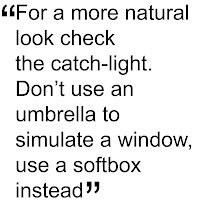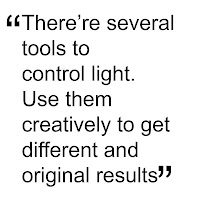Either if you shooting in a studio or outdoor, you have different ways to control and modify the light to get the the atmosphere you want. here are some of them.
Reflectors. The most popular light modifiers, they consist in a special piece of fabric over a frame and they bounce back the to the subject the light of a light-source. They can be differently coloured, being the most used white, silver and golden; each one of the colour will bounce a different kind of light, softer or harsher or , with the golden surface, warmer. White boards can be also used as reflectors, but not everyone of them is suitable for photographic purposes: the nature of the material or the painting can generate colour casts on the subjects, so you need something which reflects pure white , like a piece of expanded polystyrene.
 Softboxes. Mounted directly on the flash head, they produce a soft, involving and diffused light generating a soft edge shadow, They come in different shapes (square, rectangular, octagonal) and sizes to proper illuminate depending on the size of the area we want to light. For some photographers, the use of big soft boxes and its characteristics makes unnecessary the use of a Fill light.
Softboxes. Mounted directly on the flash head, they produce a soft, involving and diffused light generating a soft edge shadow, They come in different shapes (square, rectangular, octagonal) and sizes to proper illuminate depending on the size of the area we want to light. For some photographers, the use of big soft boxes and its characteristics makes unnecessary the use of a Fill light.
Umbrellas. They produce a wide and soft light and, if shooting subjects, a bright spot on the tip of the nose. There are two kinds of umbrellas, the ones which bounce back the light and the translucent ones which allow light to pass trough diffusely.
Snoots. Tubes or similar objects that fit over a studio light and help to control the direction of light concentrating it in a small beam. they can have a cylindrical, conical or rectangular shape. Snoots highlight a specific area of the scene leaving other areas in shadow.
Honeycomb grids. They are grids mounted on snoot, softboxes, head lamps which narrow the beam of light to a circle with soft edges. They have different degrees to a better control of light: the smaller the degree, the smaller the beam and the soft edge.
Beauty dish. It is a parabolic reflector mounted on a lamp head that focuses the light towards a point though in a soft and wrapping way. It is especially used in fashion portrait as an alternative to soft-boxes when a more contrasty and dramatic look is wanted.
Flags. They are black panels that absorb light and stop it to reach a specific area of the scene, deepening the shadows and creating contrast. The also prevent light spill into the lens. The closer they are placed to the light source, the softer will be the shadow.
 Filters. All objects that intercept light and let it pass trough without modifying the lens focal lens are filters. They can be colour gel or colour filter by which colour temperature and colour balance is controlled, colour filters to control contrast, density filters to control the quantity of light, blocking filter to block radiations, polarizing filters to control the direction of light... this theme is so extensive we need a dedicated post to talk about it. The most commonly used are colour filters; they are thin transparent coloured sheets that are placed in front of the light intercepting the beam. They come in different colours to proper balance the light being the most used the CTO (orange) and CTB (blue). Another very used filter is the diffusion filter which softens light. They have different intensities and not really a long life: lamp heat will melt them or make the colour fade, so depending on the energy absorbed, they need to be often changed.
Filters. All objects that intercept light and let it pass trough without modifying the lens focal lens are filters. They can be colour gel or colour filter by which colour temperature and colour balance is controlled, colour filters to control contrast, density filters to control the quantity of light, blocking filter to block radiations, polarizing filters to control the direction of light... this theme is so extensive we need a dedicated post to talk about it. The most commonly used are colour filters; they are thin transparent coloured sheets that are placed in front of the light intercepting the beam. They come in different colours to proper balance the light being the most used the CTO (orange) and CTB (blue). Another very used filter is the diffusion filter which softens light. They have different intensities and not really a long life: lamp heat will melt them or make the colour fade, so depending on the energy absorbed, they need to be often changed.
Barn doors. if you are shooting with continuous light yo have an extra tools: barn doors. They are metal flaps attached to a square frame on the lamp head. They block the light coming out from the source allowing to illuminate a specific area of the scene. They can be moved in different angles but be careful! always use gloves when manipulating them because they get really hot.
Cine Foil. Can you imagine barn doors which are very flexible and malleable, on where you can make cut-outs of any shape you want to create original light patterns? That is a cine foil, a black aluminium foil most used in cinematographic productions.
As you see, there are several tools to control lights. Use them creatively to get different and original results, go and experiment with them!
This comment has been removed by the author.
ReplyDeleteThis comment has been removed by the author.
ReplyDeleteThis comment has been removed by the author.
ReplyDeleteThis comment has been removed by the author.
ReplyDelete